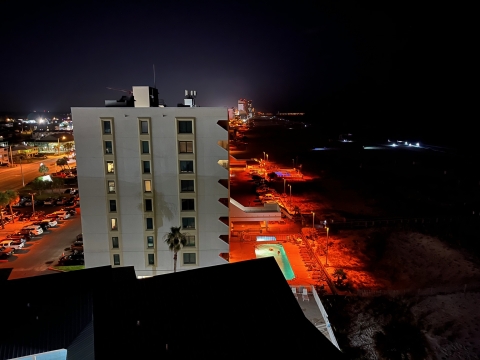ORANGE BEACH, Ala. — As another balmy summer day ends on Orange Beach, tourists slowly rise from their chairs, wiping sand off their sunburned arms and packing up for the night.
When the sun sets, hues of pink and purple fill the sky before darkness falls, changing the beach’s vibe.
At night, automatic lights suddenly appear from the tops of condominiums, hotels, and boardwalks. Young kids explore the sand with flashlights, and families use flash photography to capture special moments. Although no ill-intent is behind the bright gleam, the illumination comes with a price.
Research shows artificial lighting deters sea turtles from nesting on Alabama’s beaches, causing their population to dwindle.
Shannon Holbrook, a senior biologist with the U.S. Fish and Wildlife Service, has worked with sea turtles for eight years.
“While monitoring, volunteers started to document the disorientation of hatchlings (juvenile sea turtles) and identified light sources that were the problem,” explained Holbrook. “Hatchlings would be lost in sand dunes, roads, and swimming pools, all confused from the artificial lighting on the coast.”
Holbrook, who’s worked with the Service for more than 21 years, focuses on federally listed bats and sea turtles. Her responsibilities include monitoring and protecting three species of federally listed sea turtles: loggerhead, Kemp’s ridley, and green sea turtles. Her work is especially critical during the fragile nesting season.
“Nesting sea turtles depend on dark beaches and the light of the moon to guide them to a proper nesting area,” said Holbrook. “Once the sea turtle releases her clutch of eggs, she follows the moonlight back into the Gulf.”
As the beaches’ popularity grows, so does the array of lighting. While well-lit beaches are important for safety, these lights also hinder sea turtles from nesting. Holbrook had a challenge on her hands: how could she balance human activities with the conservation of sea turtles along the Gulf Coast?
Holbrook proposed a solution: Create partnerships with property owners to keep the beaches dim. Implementing her long-term plan required significant effort and collaboration.
“Throughout this venture, I discovered my plan would definitely take a village,” said Holbrook.
Holbrook partnered with volunteer group Share the Beach, building relationships with coastal cities like Orange Beach, Gulf Shores, Fort Morgan, and Dauphin Island. City officials soon understood the detrimental effects of artificial lighting on this keystone species.
“Millions of visitors are attracted to Orange Beach because of the sugar white sand as are the sea turtles that return to nest here,” said Nicole Woerner, Deputy Director of Coastal Resources in the city of Orange Beach. “I realize there is only so much land that is suitable nesting habitat for sea turtles and I want to ensure the balance between natural processes and human development is maintained.”
Small public meetings soon turned into large educational workshops. From homeowners’ associations to civic centers, Holbrook, Woerner, and many other partners took their educational lighting workshop on tour across the Alabama Gulf Coast. With the help of lighting experts, conservationists, city workers and volunteers, Holbrook taught hundreds of people how to transform their lights into sea turtle-friendly fixtures.
“Ideal lighting for sea turtles should be low, shielded, and red or amber in color to minimize disturbance. Even flashlights from beachgoers along the shoreline can disorient nesting females and cause problems for juveniles upon hatching,” explained Holbrook.
Developers quickly caught on. Many condo employees now distribute educational flyers, magnets, and wristbands to residents and guests. The cities of Gulf Shores and Orange Beach have both passed lighting ordinances for new construction along the coast.
Progress is truly remarkable. From the balcony of a Gulf Shores condo, the sand below is now bathed in the glow of orange orbs, interspersed with patches of amber and red light. Even flashlights cast a crimson hue.
“Going to the beach to look at the lighting typically elicits a mixture of emotions. When I see all the amber and red lights, I’m excited and encouraged by the progress we have made towards more sea turtle-friendly lighting,” said Holbrook.
Results of these efforts are encouraging. In 2023, volunteers found more than 140 sea turtle nests in Alabama, and the highest number of green and Kemp’s nests recorded in one season. The year also marked the first time volunteers recorded a green sea turtle nest on Dauphin Island.
Additionally, last year had the second lowest rate of false crawls. A false crawl is when a sea turtle comes to shore to lay eggs but turns around without depositing them on the sand. This could possibly indicate successful sea turtle education efforts as well as improved beach lighting practices.
“Sea turtle-friendly lighting has become a true passion of mine while working at the City of Orange Beach for the last 17 years,” said Woerner. “We have collaborated on lighting workshops, lighting inspections, and even protecting sea turtle hatchlings. It is encouraging to make some progress towards conservation of the sea turtle population.”
“We have come a long way – there is still a lot to do, and I’m hopeful we can continue the momentum for the conservation of this special species,” said Holbrook.









